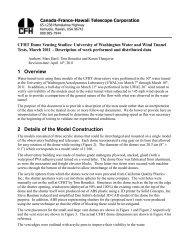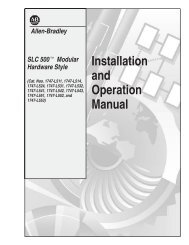Booklet ready version - Canada France Hawaii Telescope ...
Booklet ready version - Canada France Hawaii Telescope ...
Booklet ready version - Canada France Hawaii Telescope ...
Create successful ePaper yourself
Turn your PDF publications into a flip-book with our unique Google optimized e-Paper software.
Galaxy structures in the CFHTLS<br />
Cluster’s counts is an alternative method to constrain the cosmological parameters but has been largely limited<br />
by either a small redshift regime or a small area. The CFHTLS provides a major step forward to contribute in<br />
this domain. By using the CFHTLS-T0004 data release,<br />
Fig 5<br />
Example of two cluster<br />
detections with<br />
S/N~6 in the density<br />
map of the CFHTLS-D2<br />
at z~0.65-0.75. From<br />
Adami et al . (2010).<br />
Adami et al (2010) have analyzed 2.5 deg 2 in the CFHTLS Deep and 28 deg 2 in the CFHTLS Wide field to<br />
detect massive structures up to redshift<br />
z~1.5 - 1.2. They make use of the photometric<br />
redshifts from Ilbert el al<br />
(2006) and Coupon et al (2009) down to<br />
i=25 and 23 respectively. They constructed<br />
the galaxy density maps in<br />
narrow photometric redshift slices<br />
<br />
ous detection threshold (see Fig below).<br />
They end up with a list of 1200 candidates<br />
clusters increasing by a significant<br />
number previous cluster detections.<br />
In order to assess the validity of their<br />
detection rates, they have tested their<br />
method against the Millennium simulation<br />
and they also performed a clustering<br />
analysis which appears consistent<br />
with high redshift clusters measurements.<br />
These results represent the first<br />
step of this analysis. A validation and an<br />
accurate mass determination are now<br />
required to provide cosmological constraints.<br />
`OHANA-`Iki<br />
`OHANA-`Iki<br />
Difference in the signal<br />
between the two recombination<br />
paths of<br />
the interferometer on<br />
the star Antares in J-<br />
band.<br />
`OHANA-`Iki is a pair of two small telescopes (one them is shown on the<br />
right) used to feed the OHANA fibers to test the beam-combining and<br />
fringe tracking ability of the OHANA delay-line and beam combiner prior<br />
to commissioning with the CFHT and Gemini telescopes. Following the<br />
completion of the delay-line installation and in initial testing in the spring<br />
of 2009, efforts of the OHANA team for the rest of 2009 and 2010 have<br />
been aimed at obtaining internal fringes with the 300 m interferometer input<br />
fibers and then to obtain fringes on-sky with the `OHANA-`Iki telescopes.<br />
Internal fringes with the interferometer set up were first obtained in April<br />
2010 using the short (10 m) J-band fibers. Vibration of the fibers was a<br />
problem, particularly with the multi-pass setup required for auto-collimation<br />
fringes.<br />
At the end of<br />
April 2010, the<br />
second `OHA-<br />
NA-`Iki telescope was commissioned. During the<br />
June run attempts were made to obtain fringes with<br />
the `OHANA-`Iki telescopes on the star Antares.<br />
Fringes on-sky were obtained at the end of June<br />
although the fiber injection was sub-optimal and the<br />
fringes were very noisy. Chasing vibrations and<br />
more observations are scheduled for 2011.<br />
16 2009 & 2010<br />
SITELLE<br />
SITELLE is an imaging FTS (Fourier Transform Spectrograph) based on the same concept as SpIOMM, an<br />
instrument installed on the Mont Mégantic telescope. The figures on the right outline the design of the<br />
instrument: at its core is an interferometer with a friction-less scan and tip-tilt mechanism based on former<br />
Mars-mission instrument design made by ABB-Baumen, which is the main SITELLE contractor.<br />
SITELLE science goals cover a wide range of fields, thanks to the size of its field (12’x12’), its wide spectral<br />
coverage [350nm-900nm], good spatial image sampling (035”/pixel), and spectral resolution (from 1 to<br />
~20,000). Among the many topics its science case address, one can cite:<br />
• Galactic nebulae around evolved stars (PN, WR, LBVs)<br />
• Galactic HII regions: temperature fluctuations, internal structure, local enrichment, …<br />
• Abundance distribution in nearby spiral galaxies<br />
• Star-formation rate at different reshifts<br />
• Lyman-<br />
Compared to SpIOMM at Mont Mégantic, SITELLE at CFHT will be 65 (15) times better at 370nm (650)<br />
respectively.<br />
SITELLE Preliminary<br />
Design<br />
On the left, the overall<br />
instrument, as it will be<br />
mounted on the<br />
Cassegrain bonnette.<br />
On the right, the interferometer<br />
and the two<br />
camera ports.<br />
SPIRou<br />
SPIRou, an near-infrared spectro-polarimeter, was proposed by Jean-François Donati<br />
(IRAP, Toulouse). It is a natural extension of the visible spectro-polarimet ESPaDOnS to the<br />
near-IR. ESPaDOnS is currently one of the three main CFHT instruments, used for two very<br />
successful Large Programs as well as by many PIs. SPIRou will be unique not only as IR<br />
spectro-polarimeter; it will also offer the possibility of measuring radial velocity accuracy,<br />
opening the possibility of Earth-size extrasolar planets around M-dwarf stars.<br />
The science requirements of the instruments, at the end of the Phase A are<br />
as following:<br />
• Spectral domain: 0.98-2.4μm (w/ full coverage up to at least 2μm)<br />
spectral resolution > 50,000 (70,000 if possible)<br />
• Radial velocity accuracy < 1m/s<br />
• S/N=150 per 3km/s pixel in 1hr @ J=12 & K=11<br />
• Thermal instrument background < sky background, ie J>15.5, H>13.5,<br />
K>13.0<br />
• All polarization states accessible with >99% efficiency and




![Documentation [PDF] - Canada France Hawaii Telescope ...](https://img.yumpu.com/26965302/1/190x245/documentation-pdf-canada-france-hawaii-telescope-.jpg?quality=85)







